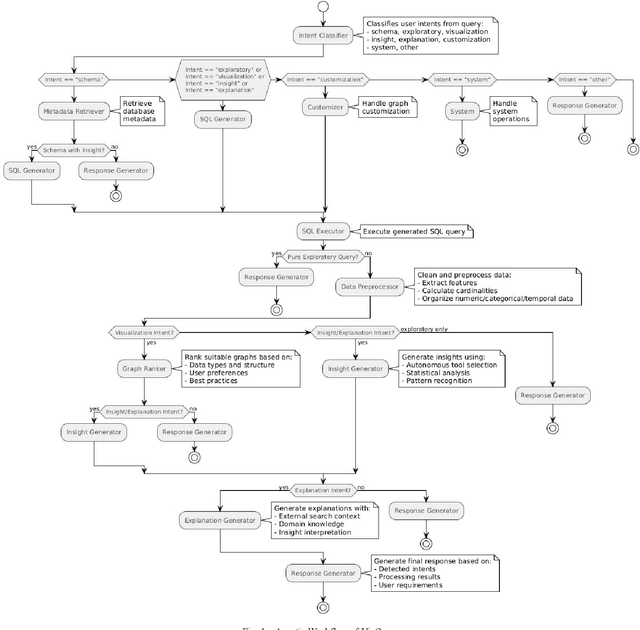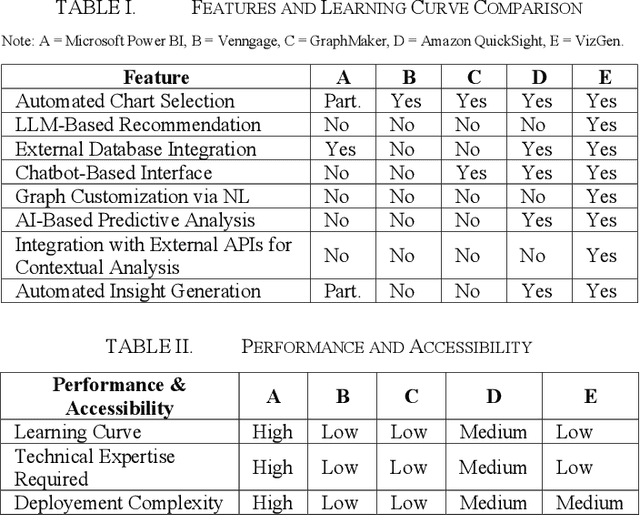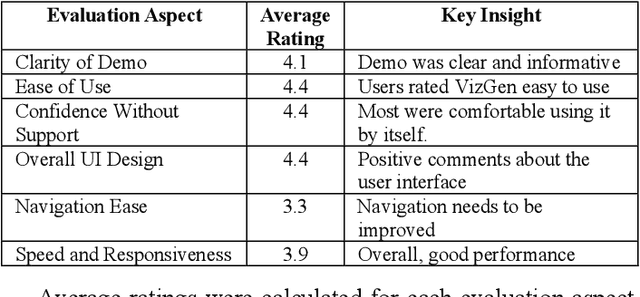Information Extraction
Information extraction is the process of automatically extracting structured information from unstructured text data.
Papers and Code
VizGen: Data Exploration and Visualization from Natural Language via a Multi-Agent AI Architecture
Sep 26, 2025



Data visualization is essential for interpreting complex datasets, yet traditional tools often require technical expertise, limiting accessibility. VizGen is an AI-assisted graph generation system that empowers users to create meaningful visualizations using natural language. Leveraging advanced NLP and LLMs like Claude 3.7 Sonnet and Gemini 2.0 Flash, it translates user queries into SQL and recommends suitable graph types. Built on a multi-agent architecture, VizGen handles SQL generation, graph creation, customization, and insight extraction. Beyond visualization, it analyzes data for patterns, anomalies, and correlations, and enhances user understanding by providing explanations enriched with contextual information gathered from the internet. The system supports real-time interaction with SQL databases and allows conversational graph refinement, making data analysis intuitive and accessible. VizGen democratizes data visualization by bridging the gap between technical complexity and user-friendly design.
From Pixels to Urban Policy-Intelligence: Recovering Legacy Effects of Redlining with a Multimodal LLM
Sep 18, 2025This paper shows how a multimodal large language model (MLLM) can expand urban measurement capacity and support tracking of place-based policy interventions. Using a structured, reason-then-estimate pipeline on street-view imagery, GPT-4o infers neighborhood poverty and tree canopy, which we embed in a quasi-experimental design evaluating the legacy of 1930s redlining. GPT-4o recovers the expected adverse socio-environmental legacy effects of redlining, with estimates statistically indistinguishable from authoritative sources, and it outperforms a conventional pixel-based segmentation baseline-consistent with the idea that holistic scene reasoning extracts higher-order information beyond object counts alone. These results position MLLMs as policy-grade instruments for neighborhood measurement and motivate broader validation across policy-evaluation settings.
SciNLP: A Domain-Specific Benchmark for Full-Text Scientific Entity and Relation Extraction in NLP
Sep 10, 2025Structured information extraction from scientific literature is crucial for capturing core concepts and emerging trends in specialized fields. While existing datasets aid model development, most focus on specific publication sections due to domain complexity and the high cost of annotating scientific texts. To address this limitation, we introduce SciNLP - a specialized benchmark for full-text entity and relation extraction in the Natural Language Processing (NLP) domain. The dataset comprises 60 manually annotated full-text NLP publications, covering 7,072 entities and 1,826 relations. Compared to existing research, SciNLP is the first dataset providing full-text annotations of entities and their relationships in the NLP domain. To validate the effectiveness of SciNLP, we conducted comparative experiments with similar datasets and evaluated the performance of state-of-the-art supervised models on this dataset. Results reveal varying extraction capabilities of existing models across academic texts of different lengths. Cross-comparisons with existing datasets show that SciNLP achieves significant performance improvements on certain baseline models. Using models trained on SciNLP, we implemented automatic construction of a fine-grained knowledge graph for the NLP domain. Our KG has an average node degree of 3.2 per entity, indicating rich semantic topological information that enhances downstream applications. The dataset is publicly available at https://github.com/AKADDC/SciNLP.
LEAP: Local ECT-Based Learnable Positional Encodings for Graphs
Oct 01, 2025Graph neural networks (GNNs) largely rely on the message-passing paradigm, where nodes iteratively aggregate information from their neighbors. Yet, standard message passing neural networks (MPNNs) face well-documented theoretical and practical limitations. Graph positional encoding (PE) has emerged as a promising direction to address these limitations. The Euler Characteristic Transform (ECT) is an efficiently computable geometric-topological invariant that characterizes shapes and graphs. In this work, we combine the differentiable approximation of the ECT (DECT) and its local variant ($\ell$-ECT) to propose LEAP, a new end-to-end trainable local structural PE for graphs. We evaluate our approach on multiple real-world datasets as well as on a synthetic task designed to test its ability to extract topological features. Our results underline the potential of LEAP-based encodings as a powerful component for graph representation learning pipelines.
MoSE: Unveiling Structural Patterns in Graphs via Mixture of Subgraph Experts
Sep 11, 2025While graph neural networks (GNNs) have achieved great success in learning from graph-structured data, their reliance on local, pairwise message passing restricts their ability to capture complex, high-order subgraph patterns. leading to insufficient structural expressiveness. Recent efforts have attempted to enhance structural expressiveness by integrating random walk kernels into GNNs. However, these methods are inherently designed for graph-level tasks, which limits their applicability to other downstream tasks such as node classification. Moreover, their fixed kernel configurations hinder the model's flexibility in capturing diverse subgraph structures. To address these limitations, this paper proposes a novel Mixture of Subgraph Experts (MoSE) framework for flexible and expressive subgraph-based representation learning across diverse graph tasks. Specifically, MoSE extracts informative subgraphs via anonymous walks and dynamically routes them to specialized experts based on structural semantics, enabling the model to capture diverse subgraph patterns with improved flexibility and interpretability. We further provide a theoretical analysis of MoSE's expressivity within the Subgraph Weisfeiler-Lehman (SWL) Test, proving that it is more powerful than SWL. Extensive experiments, together with visualizations of learned subgraph experts, demonstrate that MoSE not only outperforms competitive baselines but also provides interpretable insights into structural patterns learned by the model.
ViSpec: Accelerating Vision-Language Models with Vision-Aware Speculative Decoding
Sep 17, 2025



Speculative decoding is a widely adopted technique for accelerating inference in large language models (LLMs), yet its application to vision-language models (VLMs) remains underexplored, with existing methods achieving only modest speedups (<1.5x). This gap is increasingly significant as multimodal capabilities become central to large-scale models. We hypothesize that large VLMs can effectively filter redundant image information layer by layer without compromising textual comprehension, whereas smaller draft models struggle to do so. To address this, we introduce Vision-Aware Speculative Decoding (ViSpec), a novel framework tailored for VLMs. ViSpec employs a lightweight vision adaptor module to compress image tokens into a compact representation, which is seamlessly integrated into the draft model's attention mechanism while preserving original image positional information. Additionally, we extract a global feature vector for each input image and augment all subsequent text tokens with this feature to enhance multimodal coherence. To overcome the scarcity of multimodal datasets with long assistant responses, we curate a specialized training dataset by repurposing existing datasets and generating extended outputs using the target VLM with modified prompts. Our training strategy mitigates the risk of the draft model exploiting direct access to the target model's hidden states, which could otherwise lead to shortcut learning when training solely on target model outputs. Extensive experiments validate ViSpec, achieving, to our knowledge, the first substantial speedup in VLM speculative decoding.
Chunk Knowledge Generation Model for Enhanced Information Retrieval: A Multi-task Learning Approach
Sep 19, 2025Traditional query expansion techniques for addressing vocabulary mismatch problems in information retrieval are context-sensitive and may lead to performance degradation. As an alternative, document expansion research has gained attention, but existing methods such as Doc2Query have limitations including excessive preprocessing costs, increased index size, and reliability issues with generated content. To mitigate these problems and seek more structured and efficient alternatives, this study proposes a method that divides documents into chunk units and generates textual data for each chunk to simultaneously improve retrieval efficiency and accuracy. The proposed "Chunk Knowledge Generation Model" adopts a T5-based multi-task learning structure that simultaneously generates titles and candidate questions from each document chunk while extracting keywords from user queries. This approach maximizes computational efficiency by generating and extracting three types of semantic information in parallel through a single encoding and two decoding processes. The generated data is utilized as additional information in the retrieval system. GPT-based evaluation on 305 query-document pairs showed that retrieval using the proposed model achieved 95.41% accuracy at Top@10, demonstrating superior performance compared to document chunk-level retrieval. This study contributes by proposing an approach that simultaneously generates titles and candidate questions from document chunks for application in retrieval pipelines, and provides empirical evidence applicable to large-scale information retrieval systems by demonstrating improved retrieval accuracy through qualitative evaluation.
Data Fusion for BS-UE Cooperative MIMO-OFDM ISAC
Sep 16, 2025Integrated sensing and communication (ISAC) is a promising technique for expanding the functionalities of wireless networks with enhanced spectral efficiency. The 3rd Generation Partnership Project (3GPP) has defined six basic sensing operation modes in wireless networks. To further enhance the sensing capability of wireless networks, this paper proposes a new sensing operation mode, i.e., the base station (BS) and user equipment (UE) cooperative sensing. Specifically, after decoding the communication data, the UE further processes the received signal to extract the target sensing information. We propose an efficient algorithm for fusing the sensing results obtained by the BS and UE, by exploiting the geometric relationship among BS, UE and targets as well as the expected sensing quality in the BS monostatic and BS-UE bistatic sensing. The results show that the proposed data fusion method for cooperative sensing can effectively improve the position and velocity estimation accuracy of multiple targets, and provide a new approach on the expansion of the sensing pattern.
Efficient Extractive Text Summarization for Online News Articles Using Machine Learning
Sep 19, 2025In the age of information overload, content management for online news articles relies on efficient summarization to enhance accessibility and user engagement. This article addresses the challenge of extractive text summarization by employing advanced machine learning techniques to generate concise and coherent summaries while preserving the original meaning. Using the Cornell Newsroom dataset, comprising 1.3 million article-summary pairs, we developed a pipeline leveraging BERT embeddings to transform textual data into numerical representations. By framing the task as a binary classification problem, we explored various models, including logistic regression, feed-forward neural networks, and long short-term memory (LSTM) networks. Our findings demonstrate that LSTM networks, with their ability to capture sequential dependencies, outperform baseline methods like Lede-3 and simpler models in F1 score and ROUGE-1 metrics. This study underscores the potential of automated summarization in improving content management systems for online news platforms, enabling more efficient content organization and enhanced user experiences.
ReLAM: Learning Anticipation Model for Rewarding Visual Robotic Manipulation
Sep 26, 2025Reward design remains a critical bottleneck in visual reinforcement learning (RL) for robotic manipulation. In simulated environments, rewards are conventionally designed based on the distance to a target position. However, such precise positional information is often unavailable in real-world visual settings due to sensory and perceptual limitations. In this study, we propose a method that implicitly infers spatial distances through keypoints extracted from images. Building on this, we introduce Reward Learning with Anticipation Model (ReLAM), a novel framework that automatically generates dense, structured rewards from action-free video demonstrations. ReLAM first learns an anticipation model that serves as a planner and proposes intermediate keypoint-based subgoals on the optimal path to the final goal, creating a structured learning curriculum directly aligned with the task's geometric objectives. Based on the anticipated subgoals, a continuous reward signal is provided to train a low-level, goal-conditioned policy under the hierarchical reinforcement learning (HRL) framework with provable sub-optimality bound. Extensive experiments on complex, long-horizon manipulation tasks show that ReLAM significantly accelerates learning and achieves superior performance compared to state-of-the-art methods.
 Add to Chrome
Add to Chrome Add to Firefox
Add to Firefox Add to Edge
Add to Edge